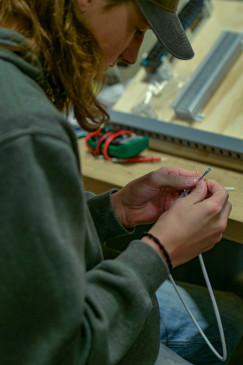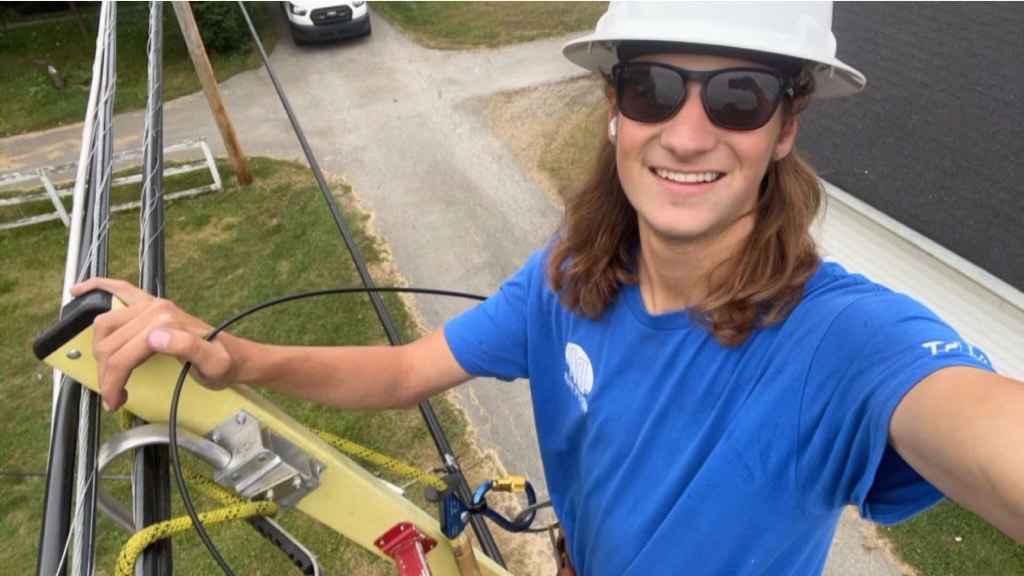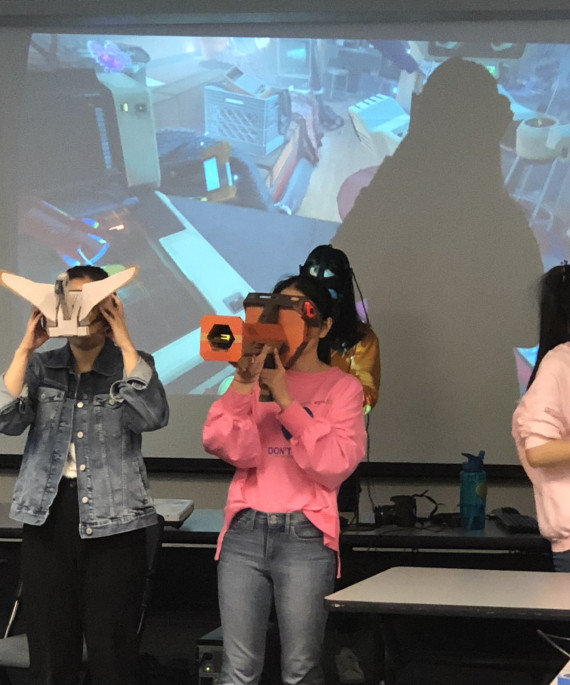
Roughly three in 10 rural Americans say they don’t have broadband internet connections in their homes, according to a 2021 Pew Research Center survey. For those who do, the service is often clunky, outdated and barely supports a Zoom call.
There are many reasons why: Few customers and high infrastructure costs make extending broadband to rural areas unprofitable for provider companies. Skilled workers are hard to find. But who knew that raccoons, snakes and spiders — or simply the fear of them — were also among the impediments to getting more rural customers online?
Allen Kiger knows. In 2022, broadband industry representatives and the Ohio Lieutenant Governor’s Office contacted Kiger’s boss, Jamie Nash, at the Buckeye Hills Career Center in Rio Grande, Ohio, asking for help. After the COVID-19 pandemic laid bare inequities Americans face in internet accessibility, the Biden Administration pumped $42.5 billion in loans and grants into extending high-speed broadband, including to rural areas. Ohio added funds, for a total investment of $500 million in the state’s rural regions. Nash asked Kiger, dean of Career Technical Education at Buckeye Hills, to take the lead developing a curriculum.
Internet providers now were incentivized to lay fiber-optic cable along America’s rural by-ways and backwoods. Doing so is expensive when terrain is rugged, and homes can be very far apart. But labor shortages made it especially challenging.
“They would spend three weeks training employees to come in and do these jobs,” Kiger said. “And then (the trainees) would basically be like, I don't want to do this.”
The trainees didn’t want to work in the cold or drive long distances. And they were completely spooked by crawlspaces.
“That was a big one … they're not going to get in those spaces because they're worried about the raccoons, snakes, spiders…” Kiger said. “They'd spend $20,000 doing training for an employee and then lose the employee. So, they were wasting money.”
Clearly, Kiger thought, if fear of critters and cold weather was standing in the way, better training was in order. Governor Mike DeWine’s Office of Workforce Transformation and experts from the college’s Center on Education and Training for Employment, a translational research center, agreed.
A statewide partnership
Could the career center, in short order, put together a training course for prospective internet technicians?
The state had allocated funds for broadband improvement in 2021, hoping to create 1,250 jobs, which would include broadband installers and technicians. They partnered with The Ohio State University and a slew of industry associations to implement a new strategy for expanding access.

The Ohio Broadband and 5G Sector Partnership aimed to increase career readiness and exploration of broadband and 5G, develop and scale training programs and leverage funding to reduce costs for participants.
Kiger and instructor Tim Henderson, a trained engineer, put together a program to begin teaching local high school seniors and adults at the career center. The certificate program uses a mock wall that students pull line through. They learned to safely climb poles and negotiate confined spaces — including those gnarly crawlspaces. Some learned to splice fiber optics.
But the state wanted to make the Buckeye Hills program scalable. That’s where Traci Lepicki came in.
Kiger likened developing the curriculum to “a whole bunch of sticky notes all over the board” — Excel spreadsheets, working documents, partial curricula. “Traci and her team came in and (took) the sticky notes and made a beautiful book for us.”
Lepicki serves as associate director of operations and strategic initiatives at the Center on Education and Training for Employment. She also leads a team to create workforce programs and train educators to teach.
“We were really focused on helping to shape and organize and make more generalizable what Buckeye Hills was doing internally for their own programming, so that it can be scaled and shared more widely,” Lepicki said.
“We could develop the best instructional material in the world, but if it’s only useful for one organization, is that helping shape the future of career readiness in the best possible way?” she said. “One of the center’s goals is to empower individuals, organizations and systems that can lead to sustained community development. This work absolutely contributes to that goal.”
Lepicki’s team worked with Buckeye Hills to enhance its 12-week curriculum based on feedback from industry experts. They also aligned it with the state’s Department of Education and Workforce content standards. This ensured the curriculum will be useful for other career centers and training providers.
“(The guide) also includes the information about what supplies and equipment you need to teach this kind of coursework and where to buy them,” Lepicki said. “We tried to make it plug-and-play so that anybody could pick it up and get the basics of what they need to do to stand up this program.”
“That made things a lot easier for us,” Kiger said, “to say ‘This is what we're doing. This is how we're doing it.’ It gave us a guide to stick to, but more importantly, it gave us an opportunity to share that information with other schools so that they can easily implement the same thing.”
“Plus, it (gives) them resources and educators to contact and say, ‘Hey, how are you doing this? Can we come down and see?’” Kiger said. “Literally, it is the guide to starting a broadband program.”
Then Lepicki’s team launched a summer pilot to train instructors who might have never been at the head of a classroom.
“In career tech ed, you get folks who are very good at their craft, but they need support in their instructional methods,” she said. “So … you might be hiring them right out of industry, so they don't necessarily have the pedagogy. The gap that we can fill with our teacher professional development is supporting those technical folks, helping them with their instructional practices.”
The team worked with career center adult secondary education instructors, too, to develop lessons that centered on broadband and 5G, “so they could teach their general adult students concepts in math and in writing, etc., in the context of a technical content area that was relevant,” Lepicki said.
Lepicki’s duties for the broadband and 5G project illustrate its wide scope. She serves on the Ohio Sector Partnership Management team. Within that, she manages the working group that develops curriculum. She also leads the central Ohio node charged with implementing the project regionally.
“That's just one part of my work,” she said.
The pandemic irreversibly changed the workforce, so workforce development must change to address those new roles and demands, said Ana-Paula Correia, director of the Center on Education and Training for Employment and professor of learning technologies.
“Having the center at the forefront of Broadband and 5G Sector Partnership in Ohio poises us to make significant contributions to the workforce of the future,” Correia said. “The workforce of the future is synchronized with technology. More than ever, the telecommunications industry needs highly skilled workers.”
First broadband and 5G program graduates on the job
Last May, Buckeye Hills celebrated its first six graduates of the program. They earned industry credentials to be certified premises cable technicians. Many were also certified to install fiber optics. Six more are likely to graduate this spring. And that’s just the start, Lepicki said.
“We're also going to see what we can do to support teacher training and the adoption of programs across the entire state,” she said. “At this point, we're going to be more focused on implementation and scaling so that there's continued programming across the state."
One star Buckeye Hills graduate is Colin Walker, of Vinton County, who landed a job when the career center hosted a job fair last spring.

“We did interviews here and (telecommunications company Horizon) came in and hired him on the spot,” Kiger said. “And then they found out that he wasn't 18 yet, so (they) had to wait to make the offer.”
Walker can rattle off the particulars of broadband and fiber optics with the best of them.
“Cat 5, or your twisted pair cabling — with that you get limited speeds because, well, you can only put so much through a little copper line,” Walker said. “But with fiber, it doesn't use electrical signals (but) uses light; there's really no cap to it that we know of yet.”
When COVID-19 hit, Walker was a freshman at Vinton County High School. He was among millions of students — both rural and urban — whose schools struggled to offer online instruction because their families had no reliable internet service.
“Our school gave out packets to do. We didn't really do a whole virtual thing,” he said.
Now he installs fiber optic service for a living in small, Ohio towns. He hopes his company will soon expand to Vinton County so he can work closer to home, helping his own community get better connected.
And, yes, Walker wriggles himself into dark and creepy crawlspaces on a regular basis.
“They don’t really freak me out, though,” he said. His training, he said, helped him to overcome the apprehension.




